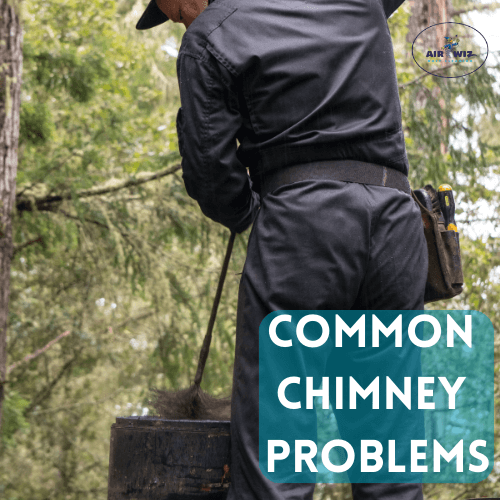Common chimney problems

When it comes to home maintenance, your chimney might not be the first thing that comes to mind. Yet, neglecting this essential part of your home can lead to many problems, some of which could pose serious risks to your family’s health and safety. So, what are the common chimney issues?
Common chimney problems include creosote accumulation, debris or nest blockage, cracked flue liners, deteriorating masonry, and damaged chimney crowns. Creosote differs from soot as it is a mixture of soot and a tar-like substance.
Here’s some more detail of what these issues entail.
Creosote buildup
Creosote is a flammable byproduct of burning wood, gas, or pellets that accumulates on the inner walls of your chimney. Creosote is available in three forms, including one that’s flaky and ash-like, another sticky like tar, and the last glossy and hard. However, they are all volatile and pose a significant fire risk if not regularly removed.
The solution
Regular cleaning by a certified chimney cleaning service is essential to remove the creosote deposits. The National Fire Protection Association recommends an annual chimney inspection to ensure no hazardous creosote buildup.
Chimney obstructions
Various forms of blockage, such as bird and animal nests, leaves, creosote buildup, and deteriorating masonry, can obstruct your chimney. These obstructions can lead to inefficient venting and dangerous situations like deadly carbon monoxide buildup. Carbon monoxide is often difficult to detect until it’s too late because of its invisible, tasteless, and odorless properties.
The solution
Installing a chimney cap can prevent debris and animals from entering the chimney. An annual inspection can also identify any existing chimney blockage, which can be promptly removed and avoid the build-up of toxic fumes.
Cracked flue liners
The chimney lining creates a crucial barrier between the combustible parts of your home and the intense temperature from the fire lit in the furnace. Like any part of your home, chimney linings wear out over time, with a mix of water and creosote worsening the process.
A cracked or damaged liner can expose your home to these harmful substances and even pose a chimney fire risk.
The solution
Generally, it’s difficult to determine if the chimney flue is intact. Special cameras are guided into the chimney to reveal the condition of the flue. If it’s damaged, it should be repaired or replaced immediately. Stainless steel liners are a durable and long-lasting option.
Masonry chimney problems
The bricks and mortar that make up your chimney can deteriorate over time, leading to instability of the chimney structure. This is often due to moisture penetration. When this happens, the chimney starts to lean, threatening to collapse.
The solution
Tuckpointing, which involves removing and replacing damaged mortar, can restore your chimney’s structural integrity. Waterproofing the bricks can also prevent further moisture damage.
Missing or damaged chimney crown or caps
The chimney cap and crown serve as the first line of defense against external elements like rain, animals, birds, and other debris. Over time, the chimney crown might crack, needing a replacement. It’s also common for chimney crowns and caps to be improperly installed.
The solution
A damaged chimney cap or crown lets moisture seep into your chimney, leading to a range of problems, such as rusting and masonry damage. Regular inspections can identify any wear and tear, and immediate repairs or replacements can prevent further damage.
Can a chimney be damaged beyond repair?
Certainly! In unfortunate instances, a chimney can deteriorate to the point where it becomes a structural and safety liability, necessitating complete replacement rather than repair. While many homeowners proactively address issues before they escalate to this level, there are cases where the extent of the damage makes the chimney irreparable.
Consulting a certified chimney professional for a comprehensive evaluation is crucial to determine whether repair or replacement is the most prudent course of action.
Hire AirWiz Duct Cleaning
Maintaining a safe and well-functioning chimney is essential for enjoying the warmth and comfort of your fireplace. Don’t let common chimney problems become a source of stress. Our experienced team is dedicated to safeguarding your home and ensuring your chimney performs at its best.
Trust AirWiz Duct Cleaning to keep your chimney in top shape and enjoy worry-free fireside moments. Contact us now to schedule your professional chimney sweep and experience the AirWiz Duct Cleaning difference. Your safety and satisfaction are our commitments.
